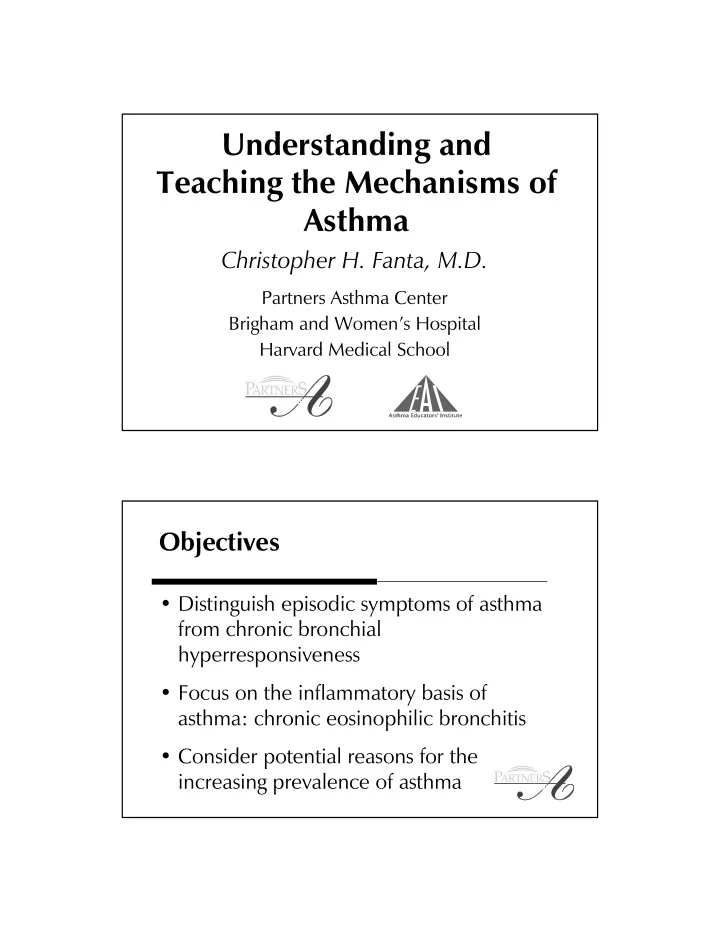

Understanding and Teaching the Mechanisms of Asthma Christopher H. Fanta, M.D. Partners Asthma Center Brigham and Women’s Hospital Harvard Medical School Objectives • Distinguish episodic symptoms of asthma from chronic bronchial hyperresponsiveness • Focus on the inflammatory basis of asthma: chronic eosinophilic bronchitis • Consider potential reasons for the increasing prevalence of asthma
Begin at the Beginning • Patient: “What does it mean to have asthma?” • Educator: “Well, asthma is a disease of the bronchial tubes in which …” • Patient: “What are bronchial tubes?” The Airways from Medicine Net.com
Asthma as Reversible Narrowing of the Bronchial Tubes • Bronchial smooth muscle (involuntary muscle) constriction • Bronchospasm; bronchoconstriction • Airway wall swelling
Bronchoscopic View After Before allergen challenge Late Asthmatic Response to Allergen 100 FEV 1 (% predicted) 75 EAR = Early asthmatic response 50 LAR = Late asthmatic response EAR 25 LAR 0 3 6 9 12 Time (hours)
Triggers of Asthmatic Reactions Universal Unique to Some Exercise (esp. in cold air) Allergens Viral resp. tract infections Aspirin/NSAIDs Irritants (fumes, smoke, etc.) Sulfites Medication (beta-blockers) Strong emotion Key Concept: Bronchial Hyperresponsiveness (“Twitchy Airways”) • Distinguishes asthmatic airways from normal airways • Is present all the time in asthma, even when one feels entirely well • Asthma is a chronic susceptibility to airway narrowing in response to triggers in our environment.
What Causes Asthmatic Airways to be “Twitchy”? • Unknown • In part, an inherited tendency • In part, airway wall inflammation Bronchial Biopsies Normal Asthmatic
Allergic-Type Inflammation in Asthma: The Players Lymphocytes: Captains of the immune response -- TH 2 lymphocytes: signal other cells (interleukins) -- B lymphocytes: make the allergy protein, IgE Mast cells: make inflammatory chemicals (“mediators”) like histamine and leukotrienes Eosinophils: make more of the inflammatory mediators Arachidonic Acid Pathway Membrane Phospholipids Phospholipase A 2 Arachidonic Acid Cyclooxygenase 5-lipoxygenase Leukotrienes C 4 , Prostaglandins D 4 , E 4 Thromboxanes Cysteinyl leukotriene receptor
Arachidonic Acid Pathway Membrane Phospholipids Phospholipase A 2 Aspirin Arachidonic Acid NSAIDs Cyclooxygenase 5-lipoxygenase Prostaglandins Leukotrienes Thromboxanes C 4 , D 4 , E 4 Cysteinyl leukotriene receptor Mast Cell Priming/Activation by IgE Busse WW, et al., NEJM 2001; 344:350.
Eosinophil Recruitment in Asthma Busse WW, et al., NEJM 2001; 344:350. What is Asthma? Asthma is a chronic eosinophilic inflammation of the bronchial tubes in which the airways narrow too much and too easily in response to environmental stimuli.
What Asthma is Not Chronic bronchitis and emphysema (COPD): permanent, largely irreversible slowing of exhalation due to long-term cigarette smoking Acute bronchitis: acute, temporary (non-allergic) inflammation of the bronchial tubes, usually due to an infection Who Gets Asthma? Children of atopic parents, esp. mothers Children with infantile atopic dermatitis (eczema) and food allergy Positive skin tests at age 3 confer increased risk of persistent asthma in school age
Allergens Relevant to Development of Asthma Dust mites (linear dose-response relationship) Cat dander (bell-shaped dose-response relationship) Mold Cockroach (especially inner cities) Occupational Asthma Repetitive exposure to workplace stimulus leads to new onset of asthma. Persons with occupational asthma develop non- specific airway hyperresponsiveness. Occupational asthma only sometimes resolves with removal from the workplace exposure.
Less Likely to Develop Asthma/Allergies Having an older sibling or going to daycare Having positive PPD skin test or evidence of other respiratory infections Exposure to high levels of endotoxin (found in animal feces) T-Cell Response and Asthma Busse WW, et al., NEJM 2001; 344:350.
The Asthma “Epidemic” In the United States, more than 22 million persons have asthma, including more than 6 million children. The annual prevalence of asthma in the U.S. increased from 3.1% in 1980 to 5.5% in 1996, a 74% increase. Epidemiology of Asthmatic Attacks 4000 deaths/year 500,000 hospitalizations/year 2 million ED visits/year
Disparities in the Asthma Burden African-Americans and Hispanics are 3 times more likely to be hospitalized for asthma or die from asthma than white Americans. Inner-City Asthma: Hospitalization Rates in Boston by Neighborhood Gottlieb DJ, et al. Chest 1995; 108:28.
Age-Adjusted* Asthma Mortality Rates by Race, United States: 1979–1998 60 Rate per million 50 Black 40 Other 30 20 White 10 0 9 1 3 5 7 9 1 3 5 7 7 8 8 8 8 8 9 9 9 9 Year 9 9 9 9 9 9 9 9 9 9 1 1 1 1 1 1 1 1 1 1 Source: Underlying Cause of Death dataset by the National Center for Health Statistics * Age-adjusted to 2000 U.S. population Can One “Outgrow” One’s Asthma? Childhood asthma often resolves spontaneously in adolescence (approx. 2/3) Recurrence of asthma is early adulthood is common (approx. 20%) Remission of adult asthma is rare (<10%).
Conclusions Asthma is a chronic allergic-like inflammation of the airways. It is characterized by persistent hyper-responsiveness and episodic narrowing of the bronchi. It is increasingly prevalent in Westernized societies, but its associated morbidity and mortality can be controlled.
Recommend
More recommend